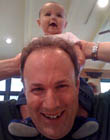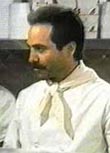|
|
This topic comprises 2 pages: 1 2
|
|
Author
|
Topic: Making small speaker baffles
|
John Walsh
Film God

Posts: 2490
From: Connecticut, USA, Earth, Milky Way
Registered: Oct 1999
|
 posted 02-14-2004 10:31 PM
posted 02-14-2004 10:31 PM




Our company is going to refurbish one of our theater complexes. It this location, there are no baffles or bafflettes behind the screen. The area behind the screen has an exit hallway, so the speakers are on top of the exit ceiling. I don't have much of a buget, but I was thinking of making small baffeletts for each speaker. The idea is that the exit hallway facing the screen could be part of the baffle; I would just place a pre-made section around the speaker, even with the existing wall.
Would there be any advantage in placing a 2ft wing on each side, and top of the speakers we're using (JBL4675's)? I'm wondering: Is a 2ft wing is too small to do any good? I'm thinking of this size because I can use one sheet of 3/4" plywood, with not much waste, for each speaker. I'd make a frame, put ductliner on the face, and bolt it to the speaker decking.
Opinions?
| IP: Logged
|
|
|
|
|
|
|
|
|
|
|
|
|
|
|
|
|
|
John Walsh
Film God

Posts: 2490
From: Connecticut, USA, Earth, Milky Way
Registered: Oct 1999
|
 posted 02-16-2004 11:25 AM
posted 02-16-2004 11:25 AM




Thanks everybody! This is a drawing of what I'm thinking of (hope it comes out OK...) The idea is, well, I can't spend too much money, so I was thinking of using just one sheet of drywall(thanks, Mark!) per speaker; I'll need a total of 27.
I wasn't planning so much of increased bass, (Ian P's idea) which is a good one, but I figured the baffle was too small. It was the reduced 'screen reflection' (Adam's idea) I was going for.
We will have a subwoofer here, but I can't have too much power, because the walls at this theater are not too well isolated; sounds can be heard in the next auditourium.
Thanks for several good ideas! If you think of anything else, please post it. If we do this, I'll take pictures and try to get an idea of if it was successful.

| IP: Logged
|
|
|
|
|
|
|
|
John Walsh
Film God

Posts: 2490
From: Connecticut, USA, Earth, Milky Way
Registered: Oct 1999
|
 posted 02-16-2004 05:38 PM
posted 02-16-2004 05:38 PM




Hi, Manny; Good point about the hallway construction.. I'll have to look at it when I'm there again. All speakers will have the Mason "Super W" pads, so at least there's a little isolation. Again, the wall isolation is not so good, so we're sort of stuck not being able to turn the sound up.
We have THX approved auditoriums that have no ductliner/insulation of any kind behind the baffle wall, neither on the baffle backside, or on the rear 'demising' wall. But those are full baffle walls, not 'bafflettes.' So the thinking is there's no way for the sound to get back there (to echo) in the first place. I did a theater recently (non-THX) and was afraid to do that, so I did put regular insulation on the rear wall just in case.
| IP: Logged
|
|
|
|
|
|
All times are Central (GMT -6:00)
|
This topic comprises 2 pages: 1 2
|
Powered by Infopop Corporation
UBB.classicTM
6.3.1.2
The Film-Tech Forums are designed for various members related to the cinema industry to express their opinions, viewpoints and testimonials on various products, services and events based upon speculation, personal knowledge and factual information through use, therefore all views represented here allow no liability upon the publishers of this web site and the owners of said views assume no liability for any ill will resulting from these postings. The posts made here are for educational as well as entertainment purposes and as such anyone viewing this portion of the website must accept these views as statements of the author of that opinion
and agrees to release the authors from any and all liability.
|

 Home
Home
 Products
Products
 Store
Store
 Forum
Forum
 Warehouse
Warehouse
 Contact Us
Contact Us




 Printer-friendly view of this topic
Printer-friendly view of this topic




















